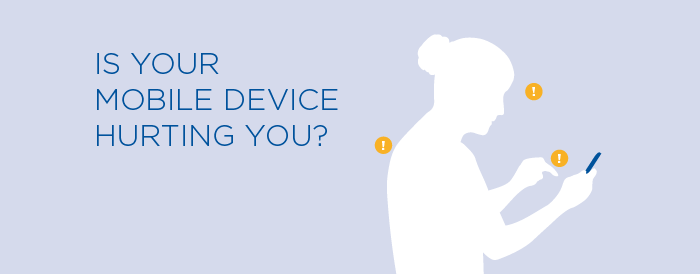IS YOUR MOBILE DEVICE HURTING YOU?
Just ask your neck, shoulders and back.

If you’re like most people, your device may not be hurting you, but your body posture while using it sure is. With a few conscious adjustments, you won’t have to give up texting or binge-watching your favorite shows.
- THE HUNCH
There’s a universal posture when using our devices, and it isn’t a good one. You know the one: Your head is bent downward and not moving, phone at chest level or lower, and chin tucked in. Doctors call this repetitive stress injury or overuse syndrome in the neck, “text neck.”
How it’s hurting you:
The average human head weighs 10 pounds in a neutral position – when your ears are over your shoulders. For every inch you tilt your head forward, the pressure on your spine doubles. A recent study published in Surgical Technology International found that lowering your head to use your device puts the force of about 60 pounds (or four bowling balls!) on your upper spine – which can speed up spinal degeneration, according to experts.
“Over time, you get tenderness in your neck, and your muscles may start to spasm—eventually, your bones can even start to change,” says Kenneth K. Hansraj, MD, chief of spine surgery at New York Spine Surgery and Rehabilitation Medicine who led the study.
Fix it now:
Rather than tilting your head down, bring your phone or tablet to chest level or slightly higher and look down at the screen with just your eyes. If you notice your chin or head is tilted, just bring it back up. It may take some re-training yourself, but it’s worth the effort!
- THE STRAIN
As much as we depend on our mobile devices, they may be causing us some vision problems. Staring at screens can bring on an array of eye issues such as blurred vision, headaches, sore eyes, headaches, muscle strain and dry eye.
How it’s hurting you:
Normally, we blink about 15 times per minute, but this rate decreases by half when we are staring at screens. We can squint to read on smaller screens, which can tighten facial, neck and shoulder muscles, while causing eye fatigue and blurred or strained vison. This series of symptoms is known as Computer Vision Syndrome.
Fix it now:
The answer is not to stop using your devices. Rather, take regular breaks about every 20 minutes or so. This is known as the 20-20-20 rule. Every 20 minutes, stare at something at least 20 feet away for at least 20 seconds. This will help rest your eyes and prevent fatigue and strain that causes those familiar headaches, soreness and blurred vision.
- THE CLAW
“Text claw” is the not-exactly-medical name for the pain you get when your wrists are in a fixed position for extended periods of time texting, typing, or web browsing. Sometimes this can lead to tendonitis, which causes wrist pain, aching, numbness, and the loss of strength.
How it’s hurting you:
Tendonitis is the breakdown of soft tissue surrounding the muscle and bones, and it is often very tender to touch. It can be pretty painful and make completing small tasks with your hands difficult. It’s not the same as carpal tunnel syndrome, although swelling from tendonitis can actually cause carpal tunnel.
Fix it now:
Alternate hands when you use your phone—it helps not only your elbow, but also your wrists. If you already have serious wrist pain, you may need a brace to keep the joint in a neutral position, putting less pressure on the soft tissue structures that may have become inflamed.
Sources: www.health.com; www.spine-health.com; www.medicaldaily.com; www.yoursightmatters.com
Full Surgical Technology International study: https://www.ncbi.nlm.nih.gov/pubmed/25393825
